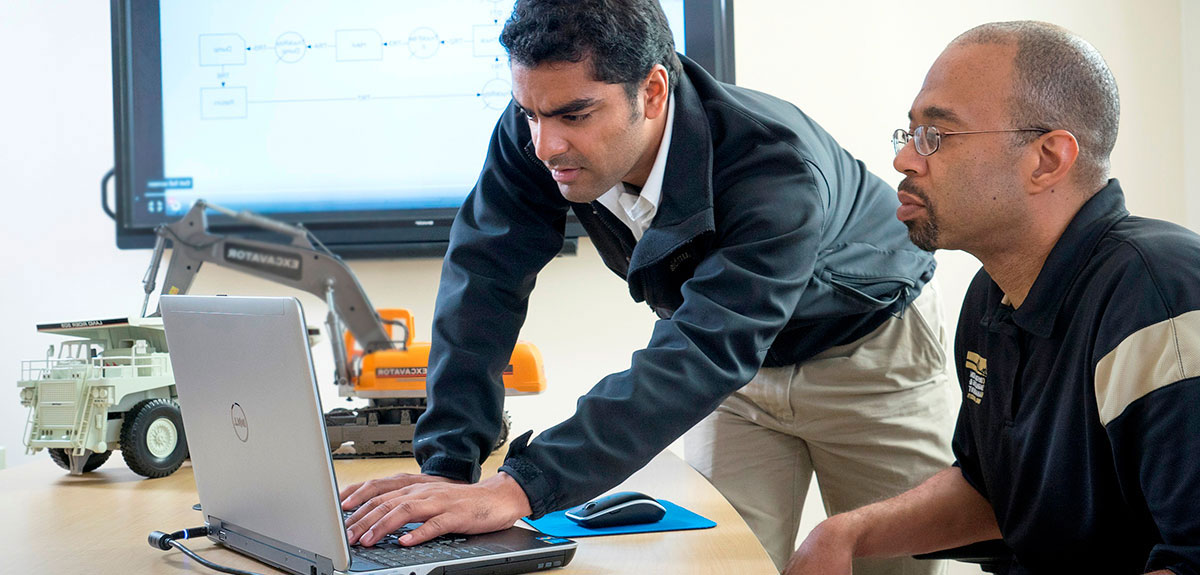Research team continues technology development to provide real-time data at construction sites
Research team continues technology development to provide real-time data at construction sites
| Author: | Hope McGowen |
|---|---|
| Magazine Section: | Research |
| Article Type: | Feature |
| Feature CSS: | background-size: 120%;
background-position: 100% 10%; |
| Page CSS: | .article #article-banner {
background-position: 80% 10% !important; } |
| Alternate Magazine Section Name: | Discovery |
Phillip Dunston, professor in Purdue’s Division of Construction Engineering and Management, and Joseph Louis, a doctoral candidate, have developed technology that will provide real-time information to project managers at construction sites, which could lead to reduced cost and time overruns.
The software, which uses an operational model of the project site and receives input from sensors at the site and on equipment, can provide real-time actionable insights to a project manager (PM).
Using traditional software, PMs are only given a high-level overview of what work needs to be done. The software created by Dunston and Louis will provide PMs with a real-time overview of the worksite operations. “Our technology puts the sensor data into the context of the operations, which allows the manager to monitor progress; make real-time, data-driven operational decisions; and automate the worksite at an operational level,” Louis says.
The potential to provide PMs with timely insights that will dramatically improve project performance is the most exciting part of the technology, according to Dunston. “We have a methodology that can be implemented in today’s construction environment,” he says. “Every project can benefit from the traditional productivity improvement cycle: plan, execute, monitor, improve plan. We are designing our system to provide real-time monitoring that would accelerate that improvement cycle.” Users will have the opportunity to make rapid improvement decisions and thus realize benefits quickly.
After two and a half years of developing these solutions, Dunston and Louis continue to work toward moving the technology from the testing phases to the market and into the hands of PMs.
“Field testing is the biggest obstacle going forward,” Dunston says. That obstacle will certainly be overcome, however. The Purdue Research Foundation Office of Technology Commercialization has facilitated multiple conversations between the research team and interested parties who have given strong indications that the technology will have a market impact.
While they have not yet established the collaborations needed to do full scale, real-world testing, they are conducting lab-based testing through a virtual construction site and are investigating the use of scale model equipment to validate the technologies.
The system has the potential to be used on project sites in the construction, mining, and agricultural sectors. For Dunston, it will affect the classroom as well.
He typically teaches courses in project controls, selection and utilization of construction equipment, and virtual reality technologies for construction. Because of the newly developed technology’s ability to accelerate the productivity improvement cycle, it will have direct implications for some of these courses.
“As we pursue this research for real-time monitoring, we are seeing that we have the means to obtain more rich and actionable insights that are typically too costly to obtain in conventional construction practice,” Dunston says. “I can even see new performance indicators and knowledge visualizations that we would begin to teach future generations of construction engineering students.”
This would be taught once the technology is fully tested, launched into market, and used in the field. To reach this end goal, Dunston and Louis continue to conduct lab-based testing, talk to potential customers, and work toward establishing industry collaborations needed to complete full scale field testing.

